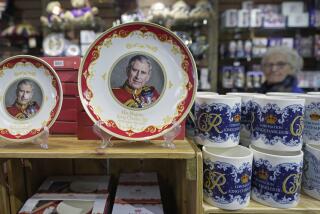Speaking of: : Buckingham Palace
LONDON — Like many of her noble subjects, Britain’s Queen Elizabeth II is bowing this summer to the sometimes cruel realities of modern economics.
Over the years, most of the stately homes in Britain have admitted the paying public to help finance upkeep. The list includes parts of Windsor Castle and the Princess of Wales’ ancestral estate, Althorp House.
But never--until now--has the world’s most famous royal residence and headquarters of the British monarchy been opened for public tours.
For eight weeks beginning Aug. 7, however, that all changes as Buckingham Palace hosts an anticipated 450,000 visitors willing to pay an adult admission of $12 for a peek at 18 of the more than 600 rooms in the palace.
The queen’s motive for inviting the public to view the sumptuous staterooms of Buckingham Palace is a variation on the one that has opened all those other stately homes: She hopes to help pay for restoration of Windsor Castle, which was badly damaged in a fire last November.
The decision is being widely applauded here as giving her subjects a chance to see their monarchical heritage up close. And the anticipated lineup for the 7,000 tickets to be sold daily is already being referred to as “the mother of all queues.”
“It’s going to be the No. 1 attraction,” said Isabel Coy, an official with the British Tourist Authority. “It’s our living heritage. The real Royal Family runs a business from there. It’s only open for a limited time, so there’s a sort of exclusive cachet.”
“There’s been enormous interest here and abroad,” adds the tourist authority’s Mark Kemmis. “It’s clearly one of those buildings like the Vatican that people would like to get into. Visitors will love to say they’ve been inside the palace. Given the excitement, a lot of people are now wondering why the queen didn’t open the palace sooner.”
The palace’s interior staterooms are usually only seen by visiting dignitaries and those receiving honors. Even invited visitors to the queen’s summer garden parties are whisked quickly through the ground floor to the 40-acre grounds behind the palace.
Depending on public reaction during the Aug. 7-Oct. 1 period this year when the palace will be open, the queen may repeat her invitation for a few weeks during each of the next five summers.
The catch for tourists is to get a ticket.
Of the 8,000 visitors that will be accepted daily, 1,000 will get their tickets from a pool set aside for groups. The remaining 7,000 tickets a day will be sold on a first-come, first-served basis from a kiosk near the palace. Each ticket specifies a 15-minute period between 9:30 a.m. and 4:30 p.m. during which the holder may enter the palace.
“The idea is to discourage ticket scalping,” explained a palace spokesman. “The tickets will be sold to purchasers on the day. They will be marked with a time at which the buyer can enter the palace. Only four tickets to a buyer.”
Foreign travel agencies--mostly in the United States--have been able to reserve only an estimated 5,000 to 6,000 tickets for the entire August-September period that the palace will be open this year.
Other foreign tourists may join the daily queue in St. James Park.
Tour Highlights
Notable Furnishings
French furniture by Riesner, Weisweiler and Carlin, Sevres and Chelsea porcelain, French and English clocks and sculpture by Canova and Chantrey.
Major Stops
1) Grand Entrance--Canopied passageway is reached by walking across interior quadrangle.
2) Ornate Grand Staircase--Leads to second-floor rooms of state.
3) Green Drawing Room--Named for green silk brocade that covers the walls and furniture. Official visitors gather here on state occasions.
4) Throne Room--Contains chairs of state for Queen Elizabeth II and Prince Philip.
5) Picture Gallery--The spine of the palace, with about 50 masterpieces by Van Dyck, Rembrandt, Rubens, Hals and Leonardo da Vinci.
6) State Dining Room--Reached through sequence of reception rooms. Contains table 8 1/4 feet wide with leaves that lengthen it to 80 feet.
7) Blue Drawing Room--Named for its ice-blue curtains, upholstery. Contains Sevres vases.
8) Music Room--Site of royal christenings, including those of Prince Charles and his elder son, Prince William. Overlooks 40-acre rear gardens.
9) White Drawing Room--Where the queen assembles the royal party before state dinners.
10) Marble Hall--Sculpture display area reached by descending Ministers’ Stairs.
11) Bow Room--Named for its deep, curved (“bowed”) bay windows.
12) Terrace and Gardens--The queen stands before mingling with her guests at garden parties. The tour continues through the Gardens, with their trees, rolling lawns, rose and herbaceous borders, a lake and pink flamingoes.
13) Grosvenor Gate--Exit after gardens.
Royal Apartments--Off-limits to tourists. Located in north wing. Family is expected to remain outside London during the eight-week viewing period.
‘Buck House’ History
Buckingham Palace traces its origins to the Duke of Buckingham, who built it originally as a town residence that he called Buckingham House. Palace officials still refer to it as “Buck House.” In 1762, the mansion was bought by George III and presented to his bride, Queen Charlotte.
In 1825, George IV had John Nash build a palace clad in Bath stone around the core of the old brick mansion. The palace was much admired by Queen Victoria, who took up residence and enlarged it.
However, many of her successors have been put off by its lack of charm and labyrinthine complexity of rooms, corridors, and stairways.
‘52 Bdrms, Vu’
Buckingham Palace contains about 600 rooms, where about 450 Royal Family members and staffers live and work. Among the rooms:
19 staterooms (the biggest, the State Ballroom, is 123 feet long and 45 feet high)
52 royal and guest bedrooms
188 staff rooms
92 offices
78 bathrooms
More to Read
Sign up for The Wild
We’ll help you find the best places to hike, bike and run, as well as the perfect silent spots for meditation and yoga.
You may occasionally receive promotional content from the Los Angeles Times.






